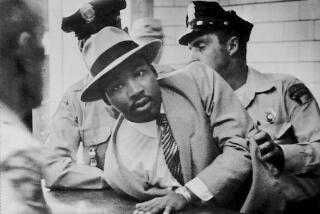Undead
- Share via
The question that echoes throughout “Sheppard Lee, Written by Himself” is: Who, or what, is Sheppard Lee? The answer seems clear enough at the start of Robert Montgomery Bird’s 1836 novel (just reissued as part of New York Review Books’ invaluable classics series). When we first encounter him, Lee is a luckless ne’er-do-well who has squandered his father’s estate and has hazy notions of entering politics. But after Lee (in the midst of a quixotic attempt to unearth buried treasure) meets a grisly fate, his ghost stumbles upon the fresh corpse of a wealthy, short-tempered brewer named Higginson, and the tale mutates into a supernatural picaresque -- as well as a time-capsule mosaic of Jackson-era America.
Lee is shocked to discover that he can shrug off whatever body he happens to occupy at the moment and enliven a new (that is to say, dead) one. This resurrection man variously assumes the guises of a rich miser, a handsome dandy, a Quaker philanthropist, even a slave; each time, he takes on not only the other person’s physical form but also his personality, talents and affections. Lee is the inverse of what we might call “a shell of a man”; he’s a weak person with a single extraordinary power. His animating spirit is odorless and colorless; all he appears to contribute to his shape-shifting identities is his own virulent strain of bad fortune. Again and again, Lee must flee one “tenement” (his word) and seek refuge in another.
What Bird, a playwright and onetime physician, created in “Sheppard Lee, Written by Himself” is an identity crisis in novel form, with its chronically amnesiac title character as an embodiment of the uncanny: Lee is neither one man nor another, neither alive nor departed. (A conundrum in the Pet Shop Boys song “The Resurrectionist” comes to mind: “We don’t bring them back to life / But we do bring them back / From the dead.”)
“There I lay on the ground, stiff and lifeless; and here I stood on my feet, alive, and surveying my own corpse, stretched before me,” Lee marvels the first time his soul shakes free of his flesh, hinting at the ample confusion to come. When Lee becomes Higginson, he is promptly accused of murdering himself. When Lee-as-Higginson becomes Dawkins the dandy, he dies saving himself from drowning. At one point, Lee checks into the body of a just-murdered man only to be re-murdered on the spot. Arguably, homicide is a constant: The protagonist is a ghost and a reanimator, but in some sense he’s also a serial killer (or perhaps a serial suicide).
Despite the book’s affinities with British gothic fiction (especially in its latter stages, it owes much to Mary Shelley and her contemporaries), its protagonist is unmistakably a native son. True to his vague political ambitions, the chameleon-like Lee evokes the adaptable sales pitch of the candidate in campaign season, making Bird’s novel an acidic parody of the country’s skin-shedding, self-inventing frontier spirit. Whoever he might be, Sheppard Lee is always quintessentially American.
More to Read
Sign up for our Book Club newsletter
Get the latest news, events and more from the Los Angeles Times Book Club, and help us get L.A. reading and talking.
You may occasionally receive promotional content from the Los Angeles Times.










